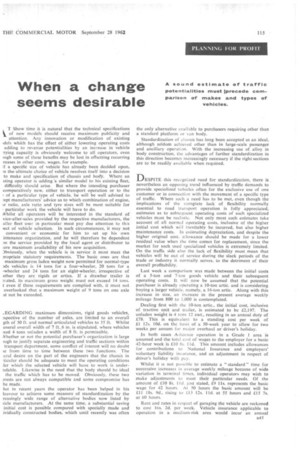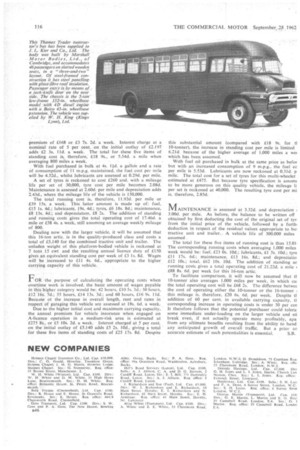When a change seems desirable
Page 121

Page 122

If you've noticed an error in this article please click here to report it so we can fix it.
T Show time it is natural that the technical specifications of new models should receive maximum publicity and attention. Any innovation or modification of existing dels which has the effect of either lowering operating costs adding to revenue potentialities by an increase in vehicle Tying capacity is obviously, welcome to all operators, even )ugh some of these benefits may be lost in offsetting recurring reases in other costs, wages, for example.
[f a specific size of vehicle has already been decided upon, n the ultimate choice of vehicle resolves itself into a decision to make and specification of chassis and bod'y. Where an sting operator is adding -a similar model to his existing fleet, difficulty should arise. But where the intending purchaser comparatively new, either to transport operation or to the of a particular type of vehicle, he will be well advised to ept manufacturers' advice as to which combination of engine, ir ratio, axle ratio and tyre sizes will be most suitable for particular work the vehicle will have to do.
Whilst all operators will be interested in the standard of vice-after-sales provided by the respective manufacturers, the aller fleet user in particular must pay due attention to this ect of vehicle selection. In such circumstances, it may not convenient or economic for him to set up his own intenance organization, and he will therefore be dependent 3n the service provided by the local agent or distributor to tire maximum availability of his new acquisition.
)bviously, when the vehicle is in service it must meet the nopriate statutory requirements. The basic ones are that maximum gross laden weight now permitted for normal-type xls vehicles is 14 tons for a four-wheeler, 20 tons for a -wheeler and 24 tons for an eight-wheeler, irrespective of ether they are rigids or attics. If a drawbar trailer is rated, its maximum gross weight must not exceed 14 tons. t even if these requirements are complied with, it must not overlooked that a maximum weight of 9 tons on one axle at not be exceeded.
.EGARDING maximum dimensions, rigid goods vehicles, ;spective of the number of axles, are limited to an overall gth of 30 ft. and normal articulated vehicles to 35 ft. Whilst eneral overall width of 7 ft. ,6 in. is stipulated, where vehicles 'eed 4 tons unladen a width of 8 ft. is permissible.
Vhether or not the potential purchaser's organization is large nigh to justify separate engineering and traffic sections within transport department, some conflict of interest will no doubt Se from time to time between these two functions. The ural desire on the part of the engineers that the chassis in .ticular should be adequate to meet the operating conditions let which the selected vehicle will have to work is underndable. Likewise is the need that the body should be ideal the traffic which has to be moved. Obviously, these two nests are not always compatible and some compromise has be made.
hit iii r&ent years the operator has been helped in his leavour to achieve some measure of standardization by the reasingly wide range of alternative bodies now listed by licle manufacturers. At the same time, a substantial saving initial cost is possible compared with specially made and ividually constructed bodies, which until recently was often the only alternative available to purchasers requiring other than a standard platform or van body.
Standardization of chassis has long been accepted as an ideal, although seldom achieved other than in large-scale passenger and ancillary operation. With the increasing use of alloy in body construction, the advantages of further standardization in this direction becomes increasingly necessary if the right sections are to be readily available when required.
DESPITE this recognized need for standardization, there is nevertheless an opposing trend influenced by traffic demands to provide specialized vehicles often for the exclusive use of one customer or in connection with the movement of a specific type of traffic. Where such a need has to be met, even though the implications of the complete lack of flexibility normally essential to road transport operation is fully appreciated, estimates as to subsequent operating costs of such specialized vehicles must be realistic. Not only must such estimates take account of all normal operating costs, inclusive of the higher initial cost which will inevitably be incurred, but also higher maintenance costs. In estimating depreciation, and despite the higher original cost, allowance should be made for a lower residual value when the time comes for replacement, since the market for such used specialized vehicles is extremely limited. On the traffic side also the lack of flexibility must mean that vehicles will be out of service during the slack periods of the trade or industry it normally serves, to the detriment of their overall profitability.
Last week a comparison was made between the initial costs of a 5-ton and 7-ton goods vehicle and their subsequent operating costs. It will now be assumed that the potential purchaser is already operating a 10-ton artic. and is considering buying a larger vehicle, namely, a 16-ton artic. Along with this increase in size, an increase in the present average weekly mileage from 800 to 1,000 is contemplated.
Dealing first with the 10-ton artic., the initial cost, inclusive of tractive unit and trailer, is estimated to be £2,197. The unladen weight is 4 tons 12 cwt., resulting in an annual duty of £78. This is equivalent to a standing cost per week of £1 12s. 10d. on the basis of a 50-week year to allow for two weeks per annum for major overhaul or driver's holiday.
In both cases A-licence operation in a Grade 1 area is assumed and the total cost of wages to the employer for a basic 42-hour week is £10 8s. lid. This amount includes allowances for contributions to National Insurance and employers' voluntary liability insurance, and an adjustment in respect of driver's holiday with pay.
Whilst it is not possible to estimate a "standard" time for successive increases in average weekly mileage because of wide variation, in terminal times, individual operators may wish to make adjustments to meet their particular needs. Of the amount of £10 8s. lid. just stated, £9 1 Is. represents the basic wage for 42 hours. At 50 hours the basic amount will be £11 18s. 9d'., rising to £13 12s. 11d. at 55 hours and 115 7s. at 60 hours.
Rent and rates in respect of garaging the vehicle are reckoned to cost 16s. 2d. per week. Vehicle insurance applicable to operation in a medium-risk area would incur an annual n45 premium of £168 or £3 7s. 2d. a week. Interest charge at a nominal rate of 5 per cent. on the initial outlay of £2,197 adds £2 3s. 1 Id. a week. The total for these five items of standing cost is, therefore, £18 9s., or 5.54d. a mile when averaging 800 miles a week.
With fuel purchased in bulk at 4s. lid. a gallon and a rate of consumption of 11 m.p.g, maintained, the fuel cost per mile will be 4.521., whilst lubricants are assessed at 0.29d. per mile.
A set of tyres is reckoned to cost £260 and, with a mileage life per set of 30,000, tyre cost per mile becomes 2.08d. Maintenance is assessed at 2,60d. per mile and depreciation adds 2.43d., where the mileage life of the vehicle is 150,000.
The total running cost is, therefore, 11.92d. per mile or £39 15s. a week. This latter amount is made up of: fuel, £15 Is. 44.; lubricants, 19s. 4d.; tyres, £6 18s. Sd.; maintenance, £8 13s. 4d.; and depreciation, £8 2s. The addition of standing . and running costs gives the total operating cost of I7.46d. a mile or £58 4s. a week, still assuming an average weekly mileage of 800.
Dealing now with the larger vehicle, it will be assumed that this 16-ton artic, is in the quality-produced class and costs a total of £5,140 for the combined tractive unit and trailer. The unladen weight ot this platform-bodied vehicle is reckoned at 7 tons 15 cwt and the resulting annual licence duty of £150 gives an equivalent standing cost per week of £3 Is. Sd. Wages will be increased to £11 4s. 6d., appropriate to the higher carrying capacity of this vehicle.
FOR 'the purpose ,of calculating the operating costs when overtime work is involved, the basic amount of wages payable in this -higher categbry would be: 42 hours, £10 5s. 3d. 50 hours, 112 'I6s: 7d.; 55 hours, £14 13s. 3d.; and 60 hours, £16 9s, I ld. Because of the increase in overall length, rent and rates in re,spect. of garaging this vehicle are assessed at 18s. 6d. a week.
Due to the higher initial cost and maximum carrying capacity, the annual premium for vehicle insurance when engaged on A-licence operation in a medium-risk area is estimated at £275 SS., or £5 10s. 2d. a week. Interest charged at 5. per cent. on the Initial outlay of £54140 adds £5 2s. 14d., giving a total for these five items of standing costs of £25 17s. 8d. Despite
this substantial amount (compared with £18 9s. for ti 10-tonrier), the increase in standing cost per mile is limited 6.21d. because of the higher average of 1,000 miles a wet which has been assumed.
With fuel oil purchased in bulk at the same price as befor but with an increased consumption of 9 m.p.g., the fuel co per mile is 5.53d. Lubricants are now reckoned at 0.31d. p mile. The, total cost for a set of tyres for this multi-wheeler estimated at £475. But because tyre specification is assumt to be more generous on this quality vehicle, the Mileage Ii per set is reckoned at 40,000. The resulting tyre cost per mi is, therefore, 2.85d.
MAINTENANCE is assessed at 3.32d. and depreciation 3.00d. per mile. AS before, the balance to be written off obtained by first deducting the cost of the original set of tyr, from the initial price of the vehicle, followed by a furthi deduction in respect of the residual values appropriate to boi tractive unit and trailer. A vehicle life of 300,000 miles assumed.
The total for these five items of running cost is thus 15.01, The corresponding running costs when averaging 1,000 miles week would he: fuel, £23 OS. 10d.; lubricants, £1 5s. 10d.; tyre £11 17s. 6d.; maintenance, £13 16s. 8d.; and depreciatio:
£12 10s.; total. £62 I0s. 10d. The addition of standing an running costs gives a total operating cost of 21.22d. a mile I £88 8s. 6d. per week for this 16-ton artic.
To facilitate comparison, it will now be assumed that LI IO-tonner also averages 1,000 miles per week, in which ea; the total operating cost will be £68 2s. The difference betwee the cost of operating either the 10-tonner or the 16-tonner this mileage is, therefore, £20 6s. 6d. per week. Despite ti addition of .60 per cent, in available carrying capacity, ti corresponding increase in operating costs is under 30 per cen It therefore 'follows that the potential purchaser could toleral some immediate under-loading on the larger vehicle and .sti break even, if not actually operate more profitably, apa. from any ultimate benefits resulting from the ability to hand any anticipated growth of overall traffic. But a prior an accurate estimate of such potentialities is essential. S.B.






































































































































































